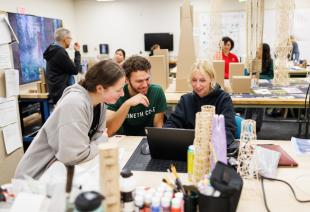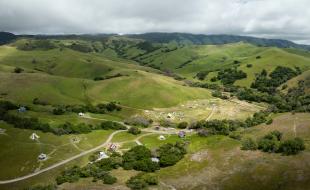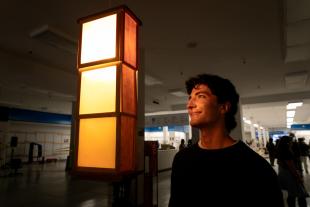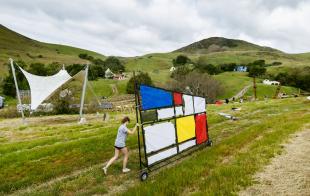At Student Furniture Competition, Unique Lamps, Tables — And a Chair You Can Wear
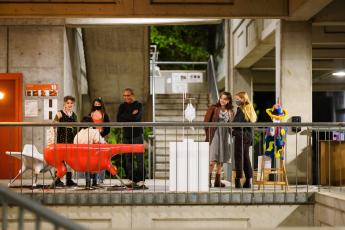
For two days in early November, the stair court in the Cal Poly Architecture Building became a gallery space for hundreds of one-of-a-kind furniture design projects, including functioning seesaws, spindled shelving units, ethereal lamps, a hydroponic table and time-lapse videos of chairs being constructed.
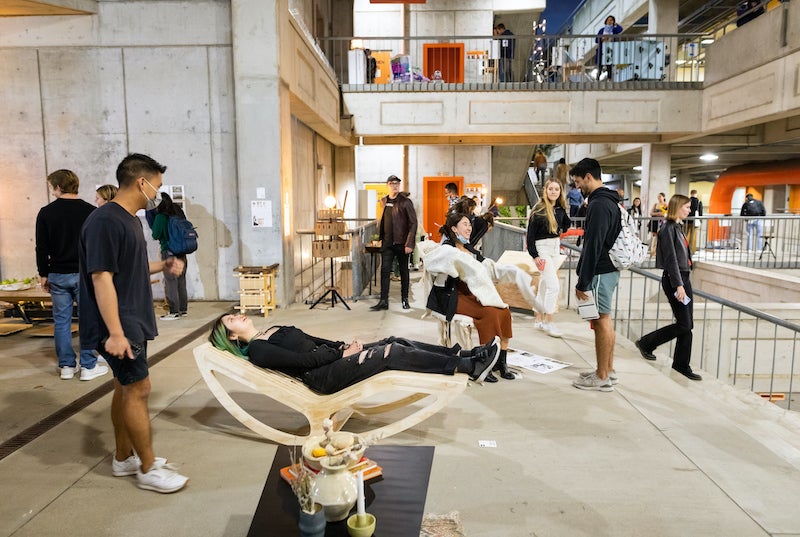
It was the culmination of the 18th annual Vellum Furniture Design Exhibition, a competition hosted jointly by San Luis Obispo firm Vellum Design Build and the College of Architecture and Environmental Design. The event gives Cal Poly architecture students the chance to experiment with design, function and construction. It was also the first in-person competition since the beginning of the pandemic — though this time, the exhibition was held on campus instead of in downtown San Luis Obispo.
Grace Johnson, a fifth-year architecture student, whose work focuses on urban agriculture, submitted a table setting comprised of patterns that, when viewed from above, abstractly resembled a landscape with mixed rural and urban uses.
“I used it as a design exercise to inform my thesis,” Johnson said. “It forced me to research rural and urban design aspects of structure and consider aesthetically how to bring urban expansion together with agricultural shapes and patterns.”
Munira Aliesa, also a fifth-year student, submitted a textile chair with knitted sleeves that were meant to be worn by the user. She called the competition a rite of passage for students in the architecture program.
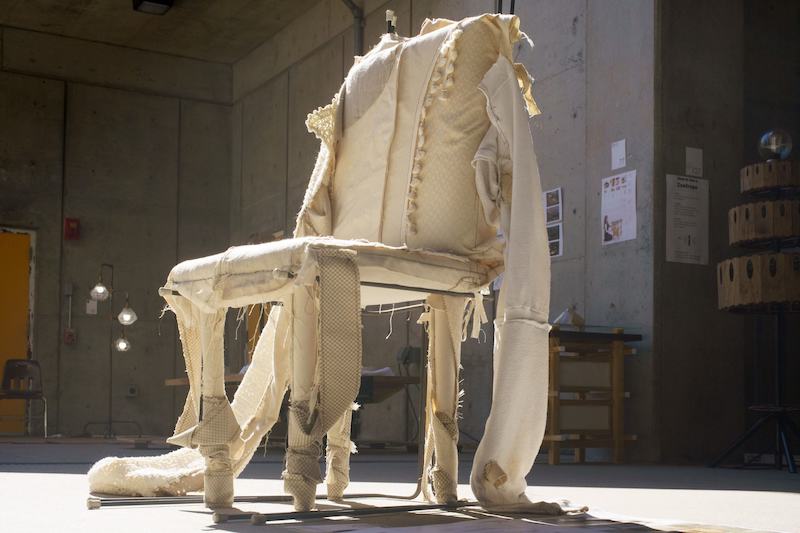
“The sheer amount of work and passion on display make you aspire to be a part of the exhibition,” Aliesa said. “It’s also an opportunity to put out work to be seen by your peers, and to see the work your peers are doing.”
The process Aliesa went through also gave her a greater understanding of her major, she said.
“Making furniture has taught me a lot about the discipline of architecture — the translation from drawing to building, and how tolerances and friction in materials that you might not anticipate can change your design and how you need to adapt for that through the build,” she said.
The origins of the competition reach back more than 20 years, to 1999, when the event’s co-organizer, Professor Tom di Santo, began teaching in Cal Poly’s architecture program and created a three-week furniture project for his students.
“The students and I would go to a junkyard and pick out found objects. Then we would react to them and make pieces of furniture. They loved it and I found it was a way to create fast design energy—to get some ideas out really quickly and to kick start a design language for the rest of the quarter,” di Santo said. “By 2004, I’d begun planning to transform this exercise into a furniture competition with my fifth-year students.”
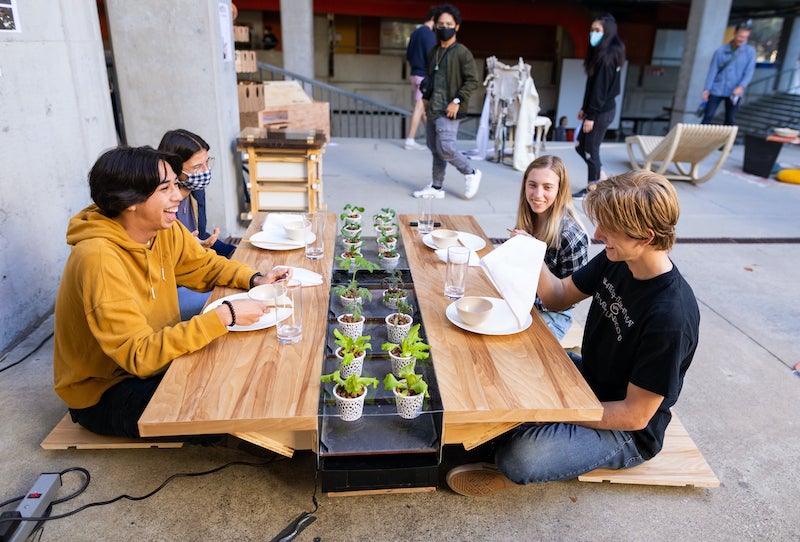
That’s when di Santo got help from a Cal Poly alumnus. Paul Abbott, the owner of Vellum Design Build and a construction management graduate, contacted di Santo about a showroom space the firm owned — and they decided to collaborate on the very first competition.
“The first year, we thought we were organizing a one-off event but we ended up having 125 entries and the exhibit was packed,” di Santo said. “There was so much energy around it. We had an amazing jury, including the inimitable landscape architecture professor Gary Dwyer, Jeff Jamieson, who is the exclusive manufacturer of Donald Judd furniture, and Anne Fougeron, a world class architect from San Francisco. We decided to do it again the next year, and then the next year, and then it kept growing. Eighteen years later, it’s still thriving.”
With more than ten award categories, and hundreds of submissions, the panel of design professionals judging the exhibition had a huge variety of work to review, and also a broad framework for assessing and recognizing the students’ projects.
Criteria across the categories ranged from overall excellence, to sustainable construction, to best uses of certain materials, to whether a student had outsourced aspects of their build or, instead, had designed and assembled every facet without assistance. The students weren’t just hoping for a high ranking — they also competed for prizes, courtesy of support from firms like Vellum Design Build, Space Architects, Studio 2G, RRM Design Group, Deadwood Revival Design, garcia architecture + design and other interested parties, such as the MYLR Gallery and Dr. Daniel Lewis, a local oncologist and supporter of the college.
The highest honor, the Space Architects Milano Grand Prize, came with the opportunity for the winner to visit Milan, all expenses paid, to attend the Salone del Mobile, the world’s largest furniture exhibition.
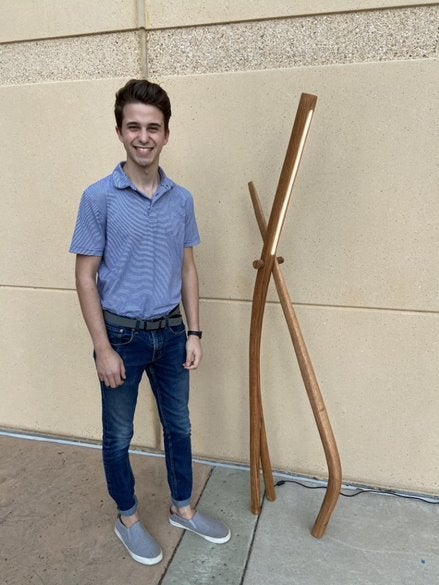
This year, Adam Harris, a third-year architecture student, took home that award for his submission, “Wish,” a lamp he constructed by steaming and bending thick boughs of timber to form an arresting and functional wishbone-shaped source of illumination.
“It was a great piece,” said di Santo. “It was well-conceived, fabricated and impeccably crafted. You had to really get in there, as an observer, to see how he was able to pull off certain connections and how to wire it. There was obviously a lot of thought put into it.”
Harris said he hopes to design spiritual spaces in the future.
“I’d like to create spaces like churches, mosques, synagogues and gardens,” he said. “I feel like this exercise will translate to how I approach light and materials, the connections between the materials and the negative space the materials create.”
When asked how he felt about the opportunity to travel to Milan, Harris said he was still processing it. “It almost hasn’t even hit me. There’s a whole world out there that I want to explore and pursue. This a way for me to touch it and see it and interact with it.”
Don't want to miss any of the best Cal Poly News stories? Sign up for our monthly newsletter, the Cal Poly News Recap!

